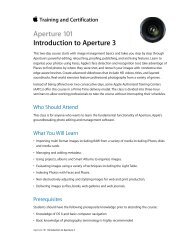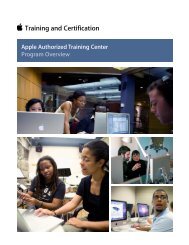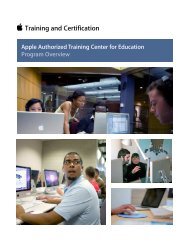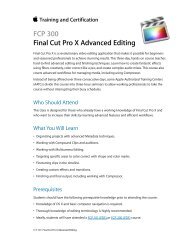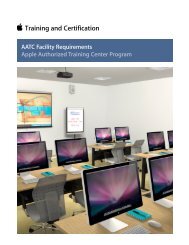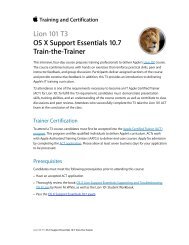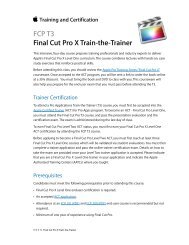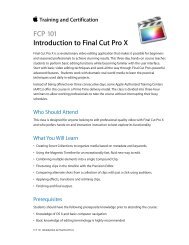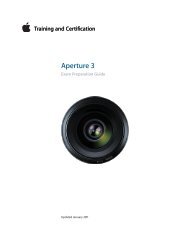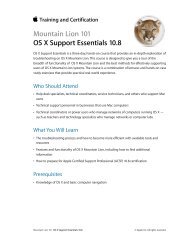OS X Support Essentials 10.8 - Training - Apple
OS X Support Essentials 10.8 - Training - Apple
OS X Support Essentials 10.8 - Training - Apple
You also want an ePaper? Increase the reach of your titles
YUMPU automatically turns print PDFs into web optimized ePapers that Google loves.
<strong>OS</strong> X <strong>Support</strong> <strong>Essentials</strong> <strong>10.8</strong> Exam Preparation Guide<br />
2. Migration Assistant can migrate information from other <strong>OS</strong> X<br />
systems, other Windows systems, and other disks (including<br />
Time Machine backups).<br />
3. System Preferences is divided into five categories, from top to<br />
bottom: Personal, Hardware, Internet & Wireless, System, and<br />
Other.<br />
4. Generally, Personal preferences affect only a single user;<br />
Hardware preferences affect hardware and peripheral<br />
settings; Internet & Wireless preferences affect personal and<br />
system network settings; and System preferences affect all<br />
users and often require administrative access.<br />
5. A configuration profile is a document, with the filename<br />
extension “.mobileconfig,” that contains system settings as<br />
defined by an administrator. Opening a configuration profile<br />
prompts the system to install the profile and configure the<br />
settings. Installed configuration profiles are managed via the<br />
Profiles preference pane.<br />
6. The system version number, build number, and serial number<br />
are located in the About This Mac dialog or login screen. The<br />
system version number defines the specific version of <strong>OS</strong> X<br />
currently installed. The system build number is an even more<br />
specific identifier used primarily by developers. Finally, the<br />
system serial number is a unique number used to identify a<br />
specific Mac.<br />
Lesson Four review questions<br />
After completing Lesson Four, you should be able to answer the following<br />
questions.<br />
1. What utilities are available when started up from <strong>OS</strong> X<br />
Recovery?<br />
2. What two resources does the local hidden <strong>OS</strong> X Recovery HD<br />
need in order to reinstall <strong>OS</strong> X Mountain Lion?<br />
3. What two methods can be used to create an external <strong>OS</strong> X<br />
Recovery disk?<br />
Answers<br />
1. The <strong>OS</strong> X Recovery system provides access to Restore From<br />
Time Machine Backup, Reinstall <strong>OS</strong> X, Get Help Online, Disk<br />
Utility, Startup Disk, Firmware Password Utility, Network<br />
Utility, Terminal, and Reset Password.<br />
2. The local hidden <strong>OS</strong> X Recovery HD doesn’t include the <strong>OS</strong> X<br />
installation assets. Thus, reinstalling <strong>OS</strong> X Mountain Lion from<br />
here requires high-speed Internet access and the ability to<br />
verify access to the installation assets. Upgraded Mac<br />
computers are verified by entering the <strong>Apple</strong> ID used to<br />
purchase <strong>OS</strong> X Mountain Lion. Conversely, verification is<br />
automatic for Mac computers that included <strong>OS</strong> X Mountain<br />
Lion.<br />
9



